Following Diagrams 7 and 8, complete the filet. Then resume weaving the remaining half bar.
On the wrong side, following the dotted line, run through the back of the klosters, to come up at "X." You will weave half a bar before working a filet in square "A," working in a clockwise sequence.
The filets in squares "B" and "C" will both start from the same place half way along the final bar. The filet in square "B" will be stitched in a counter-clockwise sequence; in square "C" it will be stitched in a clockwise sequence. Secure the thread on the wrong side through two Kloster bars.
Using the information given for the weaving and Dove's Eye filet, work the ears as shown in the master diagram.
Algerian Eyelets (Tummy)
Using the # 8 Pearl cotton and a # 24 tapestry needle, secure the thread on the wrong side and come up at # 1 in the top, left-hand corner eyelet.
Come up at odd numbers, go down in the centers. Work in diagonal rows. When the needle comes up at a junction with another eyelet, as at 9, make a detour and work that eyelet. It becomes a game like that of a maze!
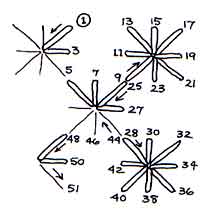
Nose, Eyes and Mouth Diagram
Following the Master Diagram, stitch the nose in Watercolours. Stitch the eyes and mouth in # 8 Pearl cotton.
Blanket Stitch Edging
To make counting easier, the edging has been drawn as Kloster stitches. Work these as Blanket Stitch.
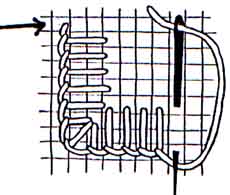
Diagram 1 - Blanket Stitch Edging
Start with an away waste knot, so that the end can be worked in LATER. Bring your needle up at the lower (loop) edge to start the blanket stitch indicated by the arrow to the left and on the master diagram.
Note: On the straight, stitches are over 3 threads. On the diagonal they are over 4 threads. This maintains the same finished width of the stitching.
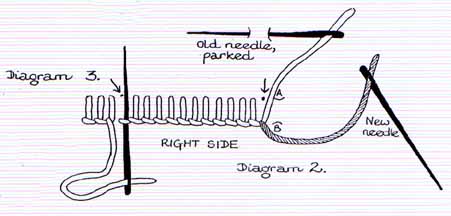
Diagram 2 & Diagram 3
It may be necessary to join your stitching when you run out of thread. Leave your old needle, still threaded, dangling on the right side. Take a new needleful of thread, slide through a sufficient number of your previous stitches on the wrong side for security. Bring your needle up to the right side next to your last loop. Take the old needle and loop it as shown in Diagram 2, parking it in the fabric above and resume stitching with the new thread, going down at "A" and up at "B."
To join where you started, stop one stitch before the first stitch as shown in Diagram 3. Slip the needle upwards through the "tail" of the first stitch. Complete the missing stitch by going down at the arrow.

Diagram 4
When enough new stitching has been established, drop the old needle down at the arrow shown in Diagram 2 and secure the thread as shown in Diagram 4, catching the starting thread so that there will not be a weak area in the join.
Your join will be invisible!
Cut the excess fabric from the WRONG side, tucking the scissor blade under the blanket stitch loops. If you feel insecure doing this, try a doodle piece first!
To Hang
Upon completion of the blanket stitch edging, attach a loop of Watercolour thread at the top and your Teddy is ready! And is completely reversible too!

About Marion
Marion Scoular was born in Palestine of British / American parents. She graduated from the Royal School of Needlework in 1955, with a 3-year Mark Excellent Diploma. At the time, Marion was the youngest student to receive the First Place Award from the Worshipful Company of Needlemakers and also the First Prize Silver Medal from the City and Guilds of London. After one year at a Cambridge Institute College, Marion taught Dressmaking in English High Schools for 3 years.
Upon emigrating to the U.S., Marion opened The Robin Hood Wool Shop in Clemson, SC and ran it for 13 years. She concurrently taught Adult Education classes at Clemson University. Marion has authored many correspondence courses, the first of which was offered by the EGA in 1970. Her current courses include Blackwork and Pulled Stitches, offered by the ANG, and Hardanger and Finishing with Flair, offered by the EGA. She has taught workshops, given lectures and judged in 40 states (with hopes to eventually include all 50!), Canada, Mexico and Australia. Further impeccable credentials include: teaching the Counted Thread Shopowner's Certification Program, being on the faculty of Callaway Gardens Needlecraft School, The Valentine Assembly (now the National Academy of Needlearts), the Council of American Embroiderers, the Smocking Arts Guild of America and the National Embroidery Teacher's Association. Marion also co-coordinated the Pinehurst Institute of Advanced Needleart and teaches at Trade shows for Wichelt Imports, Inc.
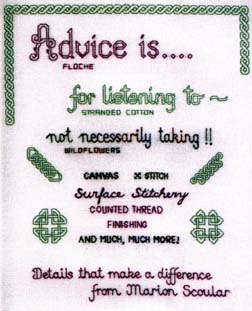
In addition to the above, Marion has contributed articles to numerous publications, has been featured on TV and has made a video on Basic Canvas Embroidery. Another vocation is leading embroidery tours abroad.
With all this on her plate, one would hardly think that Marion could have time for other leisure activities. But she does and they include sports car rallying, gymkhanas, square dancing, international folk dancing, singing, reading, listening to audio books (great, while stitching), concerts and theater going.
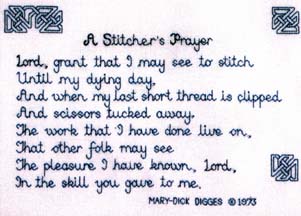
And now, Marion has written a book. One, which, not only tells you how to, but also, why. Entitled Advice is for Listening to not Necessarily Taking!!, Marion's book covers starts, joins and endings in Canvas, Cross Stitch, Hardanger, Blackwork, Pulled Stitches, Surface Stitchery and much, much more to improve the techniques you enjoy and to broaden your knowledge of others. It is packed full of tips and ideasand peppered with Words of WisdomIn sharing her "two cents' worth," Marion acknowledges that what you do with it, is up to you. Marion says of her book, " In sharing some of the many tips and ideas gleaned from over 45 years of teaching the art of the needle, I acknowledge your right to disagree with mehence the titleIt was one of my Scottish father's many phrases of wisdomIt is never too late to learn or adapt. My mother, Marjorie Reid, started taking my evening classes at the age of 60 and contributed several of the conceptsat age 65, she came to work at my shop The Robin Hood Wool Shop and at 71, she bought the shop from me, operating it until her death five years later.
Advice is for Listening to not Necessarily Taking!! is available directly from Marion for $26.00, plus $4.00 for shipping and handling. Georgia residents, please add $1.56 sales tax. Also available from Marion is her self-published booklet, Hardanger, for $8.50 plus $1.50 for shipping and handling. Georgia residents, please add $.50 sales tax. Please be patient when ordering as Marion is a strictly one-woman operation! For more information, or to order a copy of Marion Scoular's book, contact her at:
Sherwood Studio
2840 Skye Terrace
Duluth, GA 30096-6262
Phone and Fax : (770) 497- 0648
E mail: marionscoular@email.msn.com

